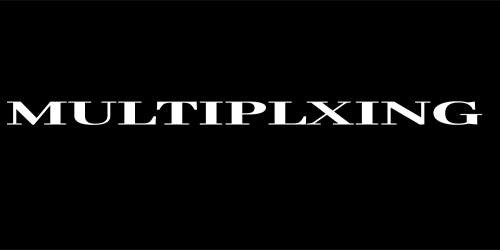Multiplexing is a technique used to combine and transmit multiple data streams through a single unit. The process of combining data streams is known as multiplexing and the hardware used for multiplexing is known as a multiplexer. In telecommunications, for example, a telephone can carry several telephone calls. Multiplexing originated in telegraphy in the 1870s and is now widely used in communication. On the telephone, George Owen Square was credited in 1910 for developing the telephone carrier multiplexing.
In analog radio transmission, signals are usually connected multiple by using frequency-division multiplexing (FDM), in which the bandwidth of a communication link is split into subchannels of different frequency widths, each carrying a single signal at the same time. A device that performs multiplexing is called a multiplexer (MUX) and a device that performs the opposite process is called a demultiplexer (DMX or DMX). The multiplexing technique divides the communication channel into several logical sub-channels. Each logical sub-channel is dedicated to a separate signal. In computing, I / O multiplexing can be used to explain the idea of processing multiple input/output events from a single event loop, such as system calls and selects (Unix) like poles. Demultiplexing is achieved using a device called Demultiplexer (DemuX) available at the end of the receipt. Demux separates a signal into its component signals (an input and N output). Therefore, we can say that multiplication follows multiple approaches within one.
Types of Multiplexing Techniques
Multiplexing techniques are mainly used in communication and they are classified into three types. The three types of multiplexing techniques include the following.
- Frequency Division Multiplexing (FDM): Frequency-division multiplexing (FDM) is inherently an analog technology. FDM receives a combination of several signals within a medium by transmitting signals across a number of distinct frequency ranges through a single. FDM In the 20th century, telephone companies used a large number of voice signals, such as a coaxial cable-like system, to a remote connection to an external connection. It is the analog multiplexing used to combine analog signals. An alternative technology known as wavelength-division multiplexing (WDM) is used in relative communications.
- Wavelength Division Multiplexing (WDM): Wavelength section multiplexing (WDM) is an analog multiplexing technique and it modulates many data streams on the light spectrum. This multiplexing is used in optical fiber. This is the most useful concept in high capacity communication systems. At the end of the transmitter section, at the end of the multiplexer signals as well as at the end of the receiver section together, D-multiplexers are used to divide the signals individually. The basic principle of using prisms is that they bend a light beam depending on the occurrence of light waves or rays and the angles of frequency. The light signal at the end of the receiver is divided into different light waves by demax.
- Time Division Multiplexing (TDM): Time-division multiplexing (TDM) is a digital (or in the rare case, analog) technology that uses time rather than space or frequency to separate different data streams. TDMs add a sequence of bits or bytes one by one from each individual input stream and in such a way that they can be connected to the appropriate receiver. TDM is primarily effective for analog and digital signals so that multiple high-speed channels used for transmissions are multiplexed. Depending on the time, each low-speed channel will be assigned to a precise location, wherever it operates in synchronized mode. TD is a legacy multiplexing technology that still provides the backbone of most national fixed-line telephony networks in Europe, providing 2m / bit voice and signaling port on Narrowband telephone exchanges such as the DMS100. Each E1 or 2m / bit TDM port provides 30 or 31 speech timeslots for CCITT7 signaling systems, and subscribers provide 30 voice channels for connected Q931, DASS2, DPNSS, V5 and CASS signal systems.














